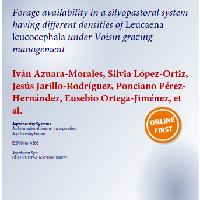Resumen
-
Available forage biomass, botanical and forage chemical compositions, stocking rates, and resting times of plants after grazing were assessed in a silvopastoral system (using Voisin grazing) having 15,000 (D15) and 25,000 Leucaena leucocephala trees ha−1 (D25), associated with Digitaria eriantha. A randomized complete block design with two replicates was used. Biomass samples were collected from July 2017 to July 2018, when grass (during rainy and transition seasons) and trees (during the dry season) achieved their optimal resting points and sheep grazed paddocks (stock density: 34–204 AU ha−1 according to season). Biomass yield was higher in D25 (15,958 ± 1190 kg DM ha−1, p < 0.05) with higher carrying capacity (2.93 ± 0.43 AU ha−1 year−1). Yield fluctuated over time (p < 0.0001) with greater biomass (p < 0.05) during the rainy (up to 3722 ± 121 kg DM ha−1), than in the transition (1800 ± 121 kg DM ha−1) and dry seasons (511 ± 121 kg DM ha−1). Between 59 and 65% of the biomass was grass during the transitional and rainy seasons, while during the dry season, 100% of the biomass was from the trees and crude protein was greater in trees (24%) than in grass (10%) biomass. Rest periods for the paddocks varied according to grazing season (from 31 to 120 days). Higher tree density increased forage biomass and yield in the silvopastoral system, which was maintained throughout the year even with seasonal precipitation because the trees sustained growth for an extended period during the year.
